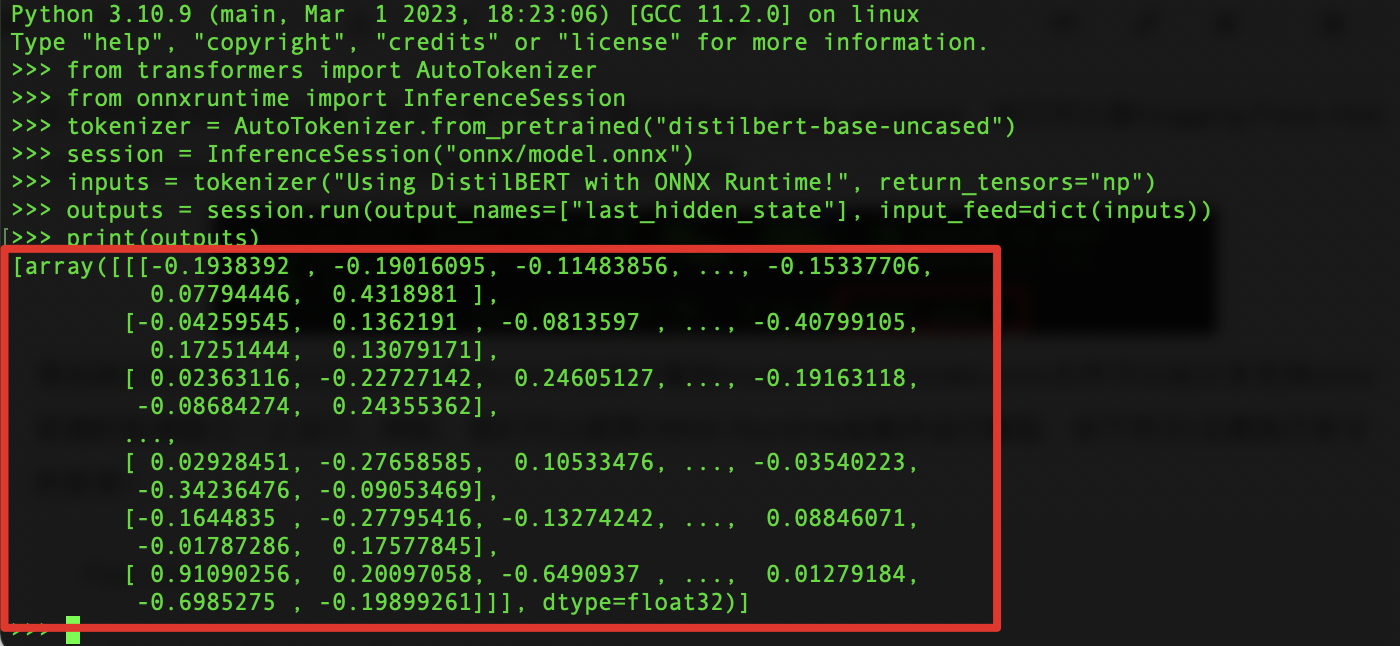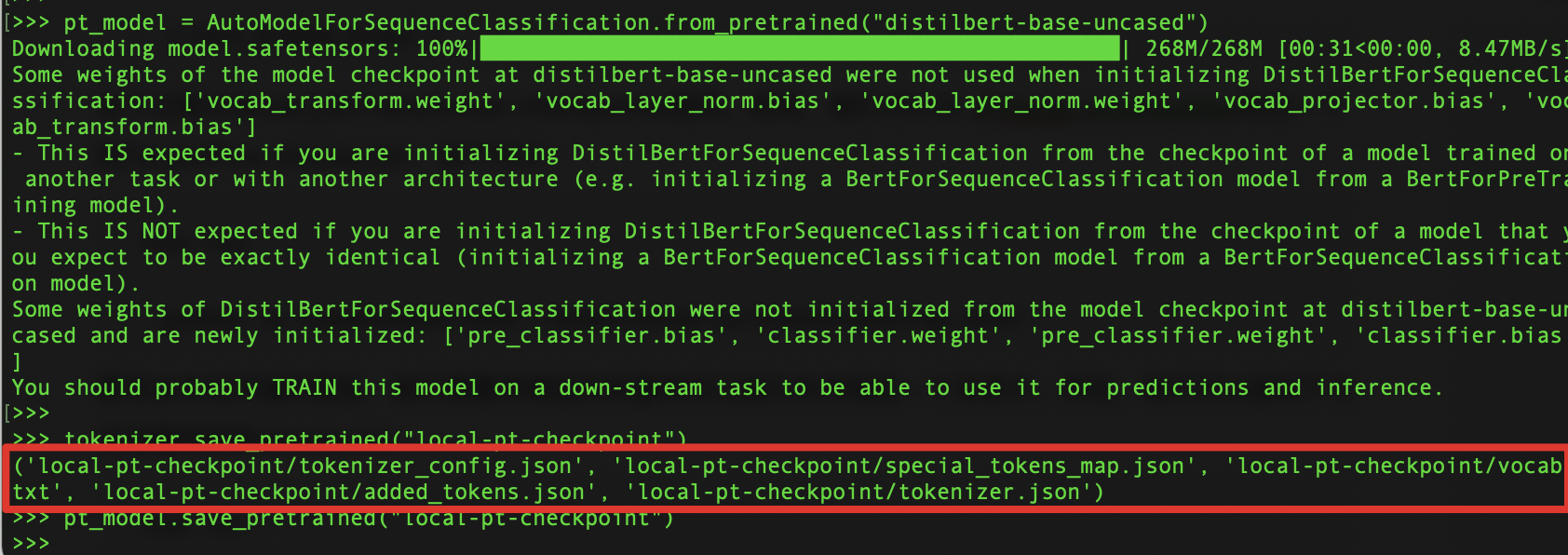系列文章:
大模型之 Huggingface 初体验
一 摘要
上一篇的初体验之后,本篇我们继续探索,将 transformers 模型导出到 onnx。这里主要参考 huggingface 的官方文档:https://huggingface.co/docs/transformers/v4.20.1/en/serialization#exporting-a-model-to-onnx。
为什么要转 onnx?如果需要部署生产环境中的 Transformers 模型,官方建议将它们导出为可在专用运行时和硬件上加载和执行的序列化格式。Transformers 模型有两种广泛使用的格式:ONNX 和 TorchScript。一旦导出,模型就可以通过量化和修剪等技术进行推理优化,这也就是需要导出的原因。
二 关于 onnx
ONNX(开放神经网络 eXchange)项目是一个开放标准,它定义了一组通用的运算符和一种通用的文件格式,以表示各种框架中的深度学习模型,包括 PyTorch 和 TensorFlow。当模型导出为 ONNX 格式时,这些运算符用于构建计算图(通常称为中间表示),该图表示通过神经网络的数据流。
ONNX 通过公开具有标准化运算符和数据类型的图,可以轻松地在框架之间切换。例如,用 PyTorch 训练的模型可以导出为 ONNX 格式,然后以 TensorFlow 导入(反之亦然)。
三 transformers 中的 onnx 包
3.1 onnx 包简介
transformers 提供了transformers.onnx包,通过使用这个包,我们可以通过利用配置对象将模型检查点转换为 ONNX 图。这些配置对象是为许多模型体系结构准备的,并且被设计为易于扩展到其他体系结构。transformers.onnx 包的源码地址:https://github.com/huggingface/transformers/tree/main/src/transformers/onnx,代码结构如下:
其中,config.py 是 onnx 提供的配置相关代码。
3.2 onnx 的相关配置
transformers 提供了三个抽象类供使用者集成,我们可以根据希望导出的模型体系结构的类型来选择集成哪一个。
Encoder-based models 继承 OnnxConfig
Decoder-based models 继承 OnnxConfigWithPast
Encoder-decoder models 继承 OnnxSeq2SeqConfigWithPast
四 transformers 导出 onnx 示例
4.1 安装环境依赖
导出 Transformers 模型到 ONNX,首先需要安装一些额外的依赖项:
pip install transformers[onnx]
复制代码
在安装完成后,transformers.onnx包就可以作为一个 Python 的 module 来使用了:
(tutorial-env) (base) [root@xxx onnx]# python -m transformers.onnx --help2023-07-09 16:50:52.082389: I tensorflow/core/platform/cpu_feature_guard.cc:182] This TensorFlow binary is optimized to use available CPU instructions in performance-critical operations.To enable the following instructions: AVX2 AVX512F FMA, in other operations, rebuild TensorFlow with the appropriate compiler flags.2023-07-09 16:50:52.965206: W tensorflow/compiler/tf2tensorrt/utils/py_utils.cc:38] TF-TRT Warning: Could not find TensorRTusage: Hugging Face Transformers ONNX exporter [-h] -m MODEL [--feature FEATURE] [--opset OPSET] [--atol ATOL] [--framework {pt,tf}] [--cache_dir CACHE_DIR] [--preprocessor {auto,tokenizer,feature_extractor,processor}] [--export_with_transformers] output
positional arguments: output Path indicating where to store generated ONNX model.
options: -h, --help show this help message and exit -m MODEL, --model MODEL Model ID on huggingface.co or path on disk to load model from. --feature FEATURE The type of features to export the model with. --opset OPSET ONNX opset version to export the model with. --atol ATOL Absolute difference tolerance when validating the model. --framework {pt,tf} The framework to use for the ONNX export. If not provided, will attempt to use the local checkpoint's original framework or what is available in the environment. --cache_dir CACHE_DIR Path indicating where to store cache. --preprocessor {auto,tokenizer,feature_extractor,processor} Which type of preprocessor to use. 'auto' tries to automatically detect it. --export_with_transformers Whether to use transformers.onnx instead of optimum.exporters.onnx to perform the ONNX export. It can be useful when exporting a model supported in transformers but not in optimum, otherwise it is not recommended.
复制代码
4.2 导出命令
使用现成的配置导出 checkpoint 可以按如下方式完成:
python -m transformers.onnx --model=distilbert-base-uncased onnx/
复制代码
在本地的执行记录如下:
2023-07-09 16:48:37.895868: I tensorflow/core/platform/cpu_feature_guard.cc:182] This TensorFlow binary is optimized to use available CPU instructions in performance-critical operations.To enable the following instructions: AVX2 AVX512F FMA, in other operations, rebuild TensorFlow with the appropriate compiler flags.2023-07-09 16:48:38.785971: W tensorflow/compiler/tf2tensorrt/utils/py_utils.cc:38] TF-TRT Warning: Could not find TensorRTFramework not requested. Using torch to export to ONNX.Loading TensorFlow model in PyTorch before exporting to ONNX.Downloading tf_model.h5: 100%|███████████████████████████████████████████████████████| 363M/363M [00:36<00:00, 9.96MB/s]2023-07-09 16:49:20.811614: I tensorflow/compiler/xla/stream_executor/cuda/cuda_gpu_executor.cc:996] successful NUMA node read from SysFS had negative value (-1), but there must be at least one NUMA node, so returning NUMA node zero. See more at https://github.com/torvalds/linux/blob/v6.0/Documentation/ABI/testing/sysfs-bus-pci#L344-L3552023-07-09 16:49:20.813190: W tensorflow/core/common_runtime/gpu/gpu_device.cc:1956] Cannot dlopen some GPU libraries. Please make sure the missing libraries mentioned above are installed properly if you would like to use GPU. Follow the guide at https://www.tensorflow.org/install/gpu for how to download and setup the required libraries for your platform.Skipping registering GPU devices...All TF 2.0 model weights were used when initializing DistilBertModel.
All the weights of DistilBertModel were initialized from the TF 2.0 model.If your task is similar to the task the model of the checkpoint was trained on, you can already use DistilBertModel for predictions without further training.Downloading (…)okenizer_config.json: 100%|████████████████████████████████████████████| 28.0/28.0 [00:00<00:00, 200kB/s]Downloading (…)solve/main/vocab.txt: 100%|████████████████████████████████████████████| 232k/232k [00:00<00:00, 600kB/s]Downloading (…)/main/tokenizer.json: 100%|███████████████████████████████████████████| 466k/466k [00:00<00:00, 1.96MB/s]Using framework PyTorch: 2.0.1+cu117/root/onnx/tutorial-env/lib/python3.10/site-packages/transformers/models/distilbert/modeling_distilbert.py:223: TracerWarning: torch.tensor results are registered as constants in the trace. You can safely ignore this warning if you use this function to create tensors out of constant variables that would be the same every time you call this function. In any other case, this might cause the trace to be incorrect. mask, torch.tensor(torch.finfo(scores.dtype).min)============= Diagnostic Run torch.onnx.export version 2.0.1+cu117 =============verbose: False, log level: Level.ERROR======================= 0 NONE 0 NOTE 0 WARNING 0 ERROR ========================
Validating ONNX model... -[✓] ONNX model output names match reference model ({'last_hidden_state'}) - Validating ONNX Model output "last_hidden_state": -[✓] (3, 9, 768) matches (3, 9, 768) -[✓] all values close (atol: 1e-05)All good, model saved at: onnx/model.onnx/root/onnx/tutorial-env/lib/python3.10/site-packages/transformers/onnx/__main__.py:178: FutureWarning: The export was done by transformers.onnx which is deprecated and will be removed in v5. We recommend using optimum.exporters.onnx in future. You can find more information here: https://huggingface.co/docs/optimum/exporters/onnx/usage_guides/export_a_model. warnings.warn(
复制代码
除了一些提示和模型的 config.json 等配置文件之外,与官方示例基本一致。 上述命令导出由--model 参数定义的检查点的 ONNX 图。在这个例子中,它是 distilbert-base-uncased,但它可以是 Hugging Face Hub 上的任何 checkpoint,也可以是本地存储的 checkpoint。
4.3 模型加载
导出执行完毕后,可以在当前目录的 onnx/目录下看到 model.onnx。model.onnx 文件可以在众多支持 onnx 标准的加速器之一上运行。例如,我们可以使用 ONNX Runtime 加载并运行模型,如下所示(注意执行命令的目录):
from transformers import AutoTokenizerfrom onnxruntime import InferenceSession
tokenizer = AutoTokenizer.from_pretrained("distilbert-base-uncased")session = InferenceSession("onnx/model.onnx")# ONNX Runtime expects NumPy arrays as inputinputs = tokenizer("Using DistilBERT with ONNX Runtime!", return_tensors="np")outputs = session.run(output_names=["last_hidden_state"], input_feed=dict(inputs))print(outputs)
复制代码
outputs 输出内容如下:
所需的输出名称(即[“last_hidden_state”])可以通过查看每个模型的 ONNX 配置来获得。例如,对于 DistilBERT,我们有:
from transformers.models.distilbert import DistilBertConfig, DistilBertOnnxConfig
config = DistilBertConfig()onnx_config = DistilBertOnnxConfig(config)print(list(onnx_config.outputs.keys()))
# 输出:["last_hidden_state"]
复制代码
这个过程与在 hub 上的 Transformer checkpoints 相同。例如,我们可以从 Keras organization导出一个纯 TensorFlow checkpoint,如下所示:
python -m transformers.onnx --model=keras-io/transformers-qa onnx/
复制代码
要导出本地存储的模型,我们需要将模型的权重和标记器文件存储在一个目录中。例如,我们可以按如下方式加载和保存 checkpoint:
Pytorch:
from transformers import AutoTokenizer, AutoModelForSequenceClassification
# 从hub加载tokenizer和PyTorch权重tokenizer = AutoTokenizer.from_pretrained("distilbert-base-uncased")pt_model = AutoModelForSequenceClassification.from_pretrained("distilbert-base-uncased")# 保存到本地磁盘tokenizer.save_pretrained("local-pt-checkpoint")pt_model.save_pretrained("local-pt-checkpoint")
复制代码
在执行 tokenizer.save_pretrained("local-pt-checkpoint")时,输出如下:
接下来我们可以在本地磁盘上看到保存下来的模型文件及相关配置:
一旦 checkpoint 被保存,我们可以通过将 transformers.ONNX 包的--model 参数指向所需的目录将其导出到 ONNX:
python -m transformers.onnx --model=local-pt-checkpoint onnx/
复制代码
TensorFlow:
from transformers import AutoTokenizer, TFAutoModelForSequenceClassification
# 从hub加载tokenizer和TensorFlow weightstokenizer = AutoTokenizer.from_pretrained("distilbert-base-uncased")tf_model = TFAutoModelForSequenceClassification.from_pretrained("distilbert-base-uncased")# 保存到tokenizer.save_pretrained("local-tf-checkpoint")tf_model.save_pretrained("local-tf-checkpoint")
复制代码
在这一步的执行中,遇到了报错:
这个问题暂时没有找到解决方案,暂时遗留。
五 小结
本篇继续学习 huggingface,尝试将模型导出为 onnx 并加载运行。后续将继续深入探索不同模型导出为 onnx 的方法。


















评论